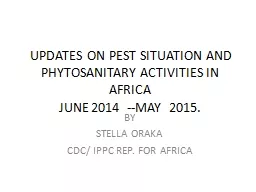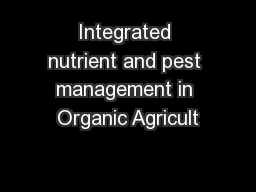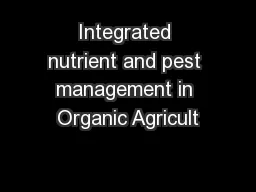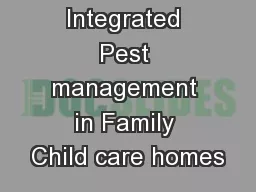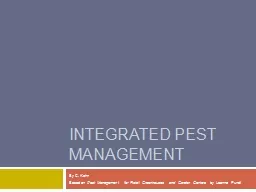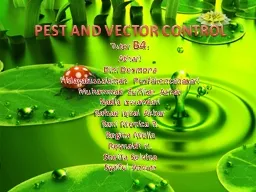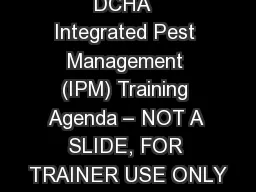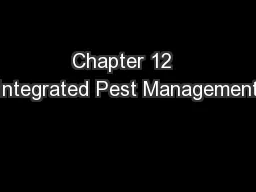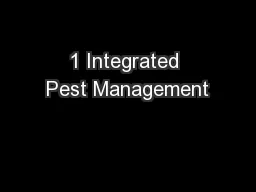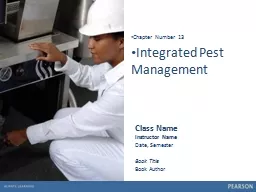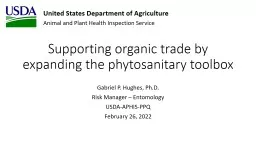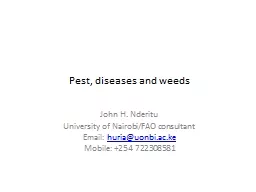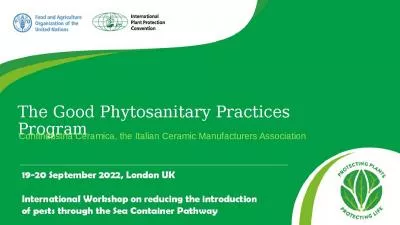PPT-UPDATES ON PEST SITUATION AND PHYTOSANITARY ACTIVITIES IN
Author : mitsue-stanley | Published Date : 2017-11-11
JUNE 2014 MAY 2015 BY STELLA ORAKA CDC IPPC REP FOR AFRICA S ituation reports of spreading invasive pests of importance Locust Emergency Response Programme in
Presentation Embed Code
Download Presentation
Download Presentation The PPT/PDF document "UPDATES ON PEST SITUATION AND PHYTOSANIT..." is the property of its rightful owner. Permission is granted to download and print the materials on this website for personal, non-commercial use only, and to display it on your personal computer provided you do not modify the materials and that you retain all copyright notices contained in the materials. By downloading content from our website, you accept the terms of this agreement.
UPDATES ON PEST SITUATION AND PHYTOSANITARY ACTIVITIES IN: Transcript
JUNE 2014 MAY 2015 BY STELLA ORAKA CDC IPPC REP FOR AFRICA S ituation reports of spreading invasive pests of importance Locust Emergency Response Programme in Madagascar Food security for 13 million at risk due to locust plague 288 million mobilized 106 needed to complete campaign by May 2015 and avoid pest resurgence and waste of applied resources Cost of ceasing is far greater than amount spent so far says FAO REP Madagascar. com Corresponding Author Abstract Nanotechnology is a promising field of interdiscipl inary research It opens up a wide array of opportunities in various fields like insecticides pharmaceuticals electronics and agriculture The potential uses and be By Kevin Raney. Overview. The United States is among the world's largest sugar producers. Unlike most other producing countries, the United States has both large and well-developed sugarcane and sugar beet industries. Since the mid-1990s, sugarcane has accounted for about 45 percent of the total sugar produced domestically, and sugar beets for about 55 percent of production. U.S. sugar production expanded from an early 1980s' average of 6.0 million short tons, raw value (STRV) to an average 8.1 million STRV in the 2000s. The production increases are due to a substantial investment in new processing equipment, the adoption of new technologies, the use of improved crop varieties, and acreage expansion (because of higher prices for sugar relative to alternative crops).. Presented by. :. Shubhendu Dash. AVP-ACCESS Development Services. Effect of chemical fertilizers on soil. Before chemical fertilizers. After applying chemical fertilizers. Cementing effect. Living soil. Presented by. :. Shubhendu Dash. AVP-ACCESS Development Services. Effect of chemical fertilizers on soil. Before chemical fertilizers. After applying chemical fertilizers. Cementing effect. Living soil. 1. University . of California, San Francisco . (UCSF) School . of Nursing. California Childcare Health . Program (CCHP). Funded . by . California Department . of Pesticide . Regulation (DPR). Icebreaker questions. By C. Kohn. Based on . Pest Management for Retail Greenhouses and Garden . Centers . by . Leanne . Pundt. Why Integrated Pest Mgmt (IPM)?. Over 90% of flowering plants and 75% of crops depend on insect pollinators. B4. :. Athari. Dini Desmona. Hidayatussalamah Pusfakencanasari. Muhammad Zulfikar Azhar. Nadia Iswandari. Rafsae Iqbal Akbar. Rani Monica R.. Regina Melia. Reynaldi H.. Sheilla Selvina. Syaiful Anwar. [Slide 2] Introductions and Group Discussion . (10 minutes). Presenters Introduce themselves, background, and qualifications. Who’s who show of hands – laborers, foremen, mechanics, property management, etc.. You Can Prevent This. Implementing an integrated pest management (IPM) program.. Working with a pest control operator (PCO). Rules of an IPM Program. Deny pests access to the operation.. Deny pests food, water, and a hiding or nesting place.. Chapter Number 13. Class Name. Instructor Name. Date, Semester. Book Title. Book Author. Learning Objectives. After this presentation, you should be able to complete the following Learning Outcomes. 13.0. Chapter Number 13. Class Name. Instructor Name. Date, Semester. Book Title. Book Author. Learning Objectives. After this presentation, you should be able to complete the following Learning Outcomes. 13.0. Gabriel P. Hughes, Ph.D.. Risk Manager – Entomology . USDA-APHIS-PPQ. February 26, 2022. United States Department of Agriculture. Animal and Plant Health Inspection Service. Photo credit: Jack Kelly, University of California. John H. . Nderitu. University of Nairobi/FAO consultant. Email: . huria@uonbi.ac.ke. Mobile: +254 722308581 . Outline . Objective . Introduction. Pests, disease and weeds. Types of damage by pests, diseases and . Confindustria Ceramica, the Italian Ceramic Manufacturers Association. From the World Trade Organization web site – “Overview”:. The World Trade Organization — the WTO — is the international organization whose primary purpose is to .
Download Document
Here is the link to download the presentation.
"UPDATES ON PEST SITUATION AND PHYTOSANITARY ACTIVITIES IN"The content belongs to its owner. You may download and print it for personal use, without modification, and keep all copyright notices. By downloading, you agree to these terms.
Related Documents

